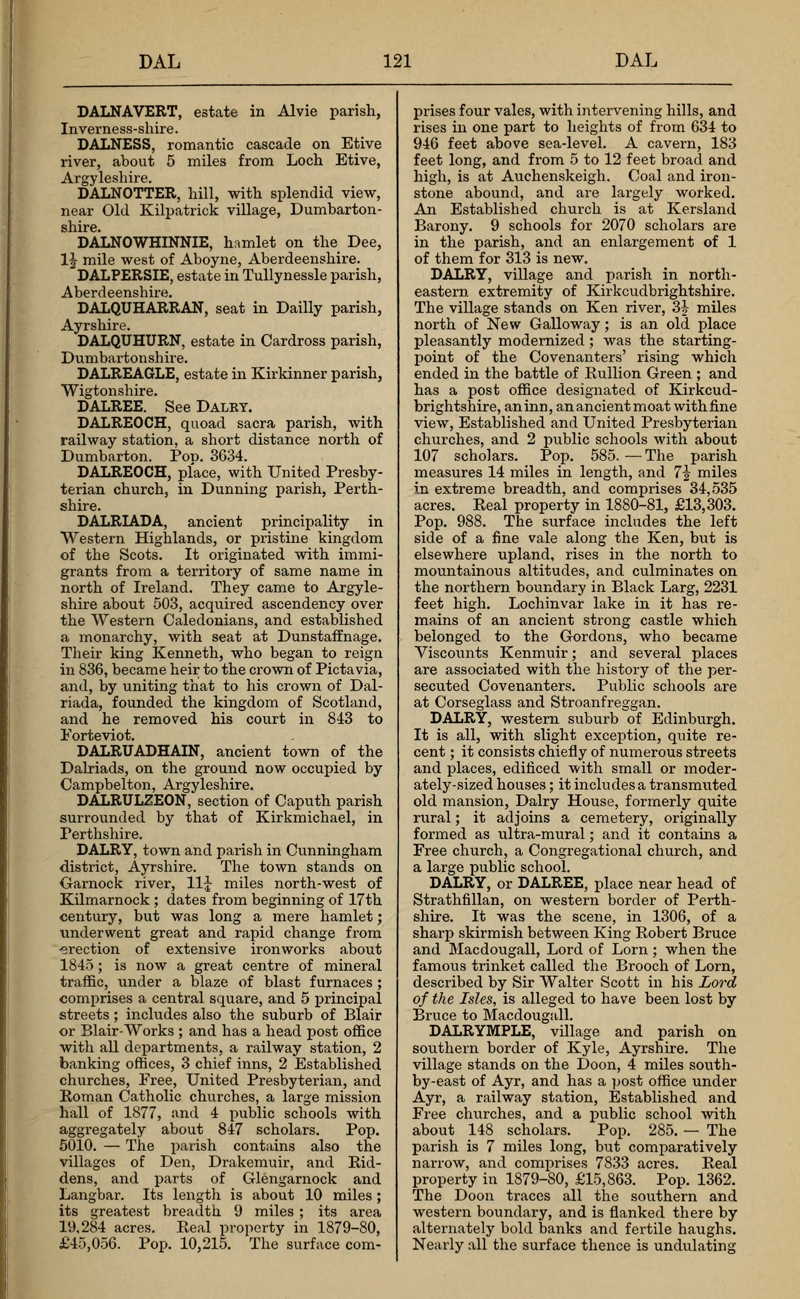DALNAVERT, estate in Alvie parish, Inverness-shire.
DALNESS, romantic cascade on Etive river, about 5 miles from Loch Etive, Argyllshire.
DALNOTTER, hill, with splendid view, near Old Kilpatrick village, Dumbartonshire.
DALNOWHINNIE, hamlet on the Dee, 1J mile west of Aboyne, Aberdeenshire.
DALPERSIE, estate in Tullynessle parish, Aberdeenshire.
DALQUHARRAN, seat in Dailly parish, Ayrshire.
DALQUHURN, estate in Cardross parish, Dumbartonshire.
DALREAGLE, estate in Kirkinner parish, Wigtonshire.
DALREE.
DALREOCH, quoad sacra parish, with railway station, a short distance north of Dumbarton. Pop. 3634.
DALREOCH, place, with United Presbyterian church, in Dunning parish, Perthshire.
DALRIADA, ancient principality in Western Highlands, or pristine kingdom of the Scots. It originated with immigrants from a territory of same name in north of Ireland. They came to Argyleshire about 503, acquired ascendency over the Western Caledonians, and established a monarchy, with seat at Dunstaffnage. Their king Kenneth, who began to reign in 836, became heir to the crown of Pictavia, and, by uniting that to his crown of Dalriada, founded the kingdom of Scotland, and he removed his court in 843 to Forteviot.
DALRUADHAIN, ancient town of the Dalriads, on the ground now occupied by Campbelton, Argyleshire.
DALRULZEON, section of Caputh parish surrounded by that of Kirkmichael, in Perthshire.
DALRY, town and parish in Cunningham district, Ayrshire. The town stands on Garnock river, 11J miles north-west of Kilmarnock ; dates from beginning of 17th century, but was long a mere hamlet; underwent great and rapid change from erection of extensive ironworks about 1845 ; is now a great centre of mineral traffic, under a blaze of blast furnaces ; comprises a central square, and 5 principal streets ; includes also the suburb of Blair or Blair-Works ; and has a head post office with all departments, a railway station, 2 banking offices, 3 chief inns, 2 Established churches, Free, United Presbyterian, and Roman Catholic churches, a large mission hall of 1877, and 4 public schools with aggregately about 847 scholars. Pop. 5010. The parish contains also the villages of Den, Drakemuir, and Riddens, and parts of Glengarnock and Langbar. Its length is about 10 miles ; its greatest breadth 9 miles ; its area 19,284 acres. Pveal property in 1879-80, 45,056. Pop. 10,215. The surface com-prises four vales, with intervening hills, and rises in one part to heights of from 634 to 946 feet above sea-level. A cavern, 183 feet long, and from 5 to 12 feet broad and high, is at Auchenskeigh. Coal and iron-stone abound, and are largely worked. An Established church is at Kersland Barony. 9 schools for 2070 scholars are in the parish, and an enlargement of 1 of them for 313 is new.
DALRY, village and parish in north-eastern extremity of Kirkcudbrightshire. The village stands on Ken river, 3J miles north of New Galloway ; is an old place pleasantly modernized ; was the starting-point of the Covenanters' rising which ended in the battle of Bullion Green ; and has a post office designated of Kirkcudbrightshire, an inn, an ancient moat with fine view, Established and United Presbyterian churches, and 2 public schools with about 107 scholars. Pop. 585. The parish measures 14 miles in length, and 1\ miles in extreme breadth, and comprises 34,535 acres. Real property in 1880-81, 13,303. Pop. 988. The surface includes the left side of a fine vale along the Ken, but is elsewhere upland, rises in the north to mountainous altitudes, and culminates on the northern boundary in Black Larg, 2231 feet high. Lochinvar lake in it has re-mains of an ancient strong castle which belonged to the Gordons, who became Viscounts Kenmuir; and several places are associated with the history of the persecuted Covenanters. Public schools are at Corseglass and Stroanfreggan.
DALRY, western suburb of Edinburgh. It is all, with slight exception, quite re-cent ; it consists chiefly of numerous streets and places, edificed with small or moderately-sized houses ; it includes a transmuted old mansion, Dairy House, formerly quite rural ; it adjoins a cemetery, originally formed as ultra-mural ; and it contains a Free church, a Congregational church, and a large public school.
DALRY, place near head of Strathfillan, on western border of Perthshire. It was the scene, in 1306, of a sharp skirmish between King Robert Bruce and Macdougall, Lord of Lorn ; when the famous trinket called the Brooch of Lorn, described by Sir Walter Scott in his Lord of the Isles, is alleged to have been lost by Bruce to Macdougall.
DALRYMPLE, village and parish on southern border of Kyle, Ayrshire. The village stands on the Doon, 4 miles south-by-east of Ayr, and has a post office under Ayr, a railway station, Established and Free churches, and a public school with about 148 scholars. Pop. 285. The parish is 7 miles long, but comparatively narrow, and comprises 7833 acres. Real property in 1879-80, 15,863. Pop. 1362. The Doon traces all the southern and western boundary, and is flanked there by alternately bold banks and fertile haughs. Nearly all the surface thence is undulating or rolling, and abounds in knolls or mound-ish hills. Four lakes, Martinham, Kerse, Snipe, and Lindston, add beauty to the landscape. The seats are Skeldon and Hollybush ; and the antiquities are the site of Dalrymple Castle, the line of a Roman road, and vestiges of 3 small Caledonian forts.

